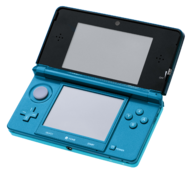3DS Model Differences
Page content & researching collaboratively taken from io55.net's 3DS page with permission.
There are six retail 3DS models.
Retail Models
Models are arranged chronologically. All original/"old" 3DS models use full size SD cards, whereas all New models use microSD cards. It is also common for displays on all 3DS models to have a yellowed appearance if they were exposed to UV or heat for a long time.
Original/"Old" Models
All original 3DS models only ship with TN displays.
Nintendo 3DS [CTR-001] (2011-2014?)
The original launch model of the 3DS. It is identified by its distinct shell design, a glossy black bezel surrounding the top screen, lack of a 2nd analogue stick and ZL/ZR buttons, non-colored ABXY buttons, and slightly more “ridged” outer shell. It is also the smallest retail model of the 3DS. Since this 3DS model has the smallest screen sizes, it also has the sharpest pixel density compared to all other models. Internally, the SD card slot is also a modular non-soldered component. The game cartridge slot is still soldered, however.
Nintendo 3DS XL [SPR-001] (2012-2015?)
The original XL version of the 3DS. It can be identified by its larger clamshell form factor compared to the original, the shell having a more rounded appearance compared to other models, lack of a second analogue stick and ZL/ZR buttons, non-colored ABXY buttons, and the start/select/home buttons being rectangles under the bottom screen. Outside of the larger form factor and minor button changes, the original 3DS XL is essentially the same as the non-XL original 3DS, although the OG XL does have a slightly longer battery life. The original 3DS XL also has cheaper build quality than the original CTR-001, and the SD card slot was changed to be soldered.
Nintendo 2DS [FTR-001] (2013-2017?)
Nintendo's first foray in removing the 3D and making an even cheaper budget-focused version of the 3DS. Very easily identified by it's “slate” form factor which does not close, non-colored ABXY buttons, and the lack of a 3D slider. Outside of it's very odd form factor and lack of 3D, the 2DS also has removed the stereo speakers and downgraded from the screens found on the OG 3DS systems, bringing the 2DS sound output to only mono without headphones. Furthermore, battery life is slightly longer, and sleep mode is instead activated by a switch. Lastly, the Circle Pad Pro will not work on these systems, making these really only matter in the realm of budget, as the OG 2DS is easily the cheapest 3DS on the 2nd hand market.
"New" Models
New Nintendo 3DS XL [RED-001] (2014-2019)
Nintendo's first foray in making “Pro” refreshes of their systems. Oddly, in Japan, the XL released a few days before the non-XL “New” 3DS. Easily identified by its larger form factor (compared to original 3DS), colored ABXY buttons, presence of a 2nd analogue stick, camera located above the top screen, home button below the bottom screen, and presence of a 3D slider. Improvements coming with this model are very fully fledged, including a 2nd analogue stick, integrated NFC, faster CPU, more RAM, better 3D capabilities + head tracking, a small library of exclusive-to-“New” games, ZL and ZR buttons, automatic brightness adjustments, and more. Some "New" 3DSes may also come with IPS screens on the bottom, top, or both unlike original 3DS or original/"New" 2DS models. These are essentially the strongest version of the 3DS when it comes to raw power and features, with their only downside being a somewhat higher price on the 2nd hand market.
New Nintendo 3DS [KTR-001] (2014-2017)
Very similar to the XL version of the “New” 3DS. Can be identified by it's smaller form factor, 3D slider, and presence of a 2nd analogue stick. The only major differences between the XL and non-XL “New” 3DSes, is that the non-XL has interchangeable faceplates, plus it's a tiny bit larger (both in screens and form factor) than the original non-XL 3DS systems. These models also have a chance to come with an IPS screen on the top, bottom, or both like its XL brother. This makes the non-XL “New” essentially the same console as the XL "New", except it's smaller and more personable. Alas, the non-XL “New” does have one downside in that it is easily the most expensive of all the 3DS models out there, due to it's relative unpopularity in much of the world compared to the XLs.
New Nintendo 2DS XL [JAN-001] (2017-2020)
Somewhat between the “New” 3DSes and the original 2DS in capabilities. Easily identified by the non-slate clamshell design, the camera being in between the two screens, the home button being to the bottom left of the bottom screen, the lack of a 3D slider, and slightly “rounded” top and bottom halves of the system. Most of the changes between the “New” 3DS and “New” 2DS are downgrades, as the “New” 2DS has poorer screen quality (guaranteed TN), less powerful speakers, and a slightly cheaper feel and function all around. Of course, with the “New” 2DS being a budget-oriented console, this comes as no surprise.
References
https://en.wikipedia.org/wiki/Nintendo_3DS
https://en.wikipedia.org/wiki/Nintendo_2DS
https://en.wikipedia.org/wiki/New_Nintendo_3DS
https://en.wikipedia.org/wiki/New_Nintendo_2DS_XL
https://www.destructoid.com/nintendo-has-seemingly-discontinued-the-original-3ds/
